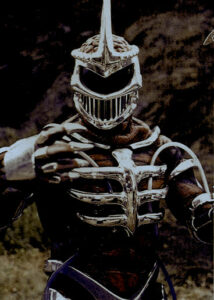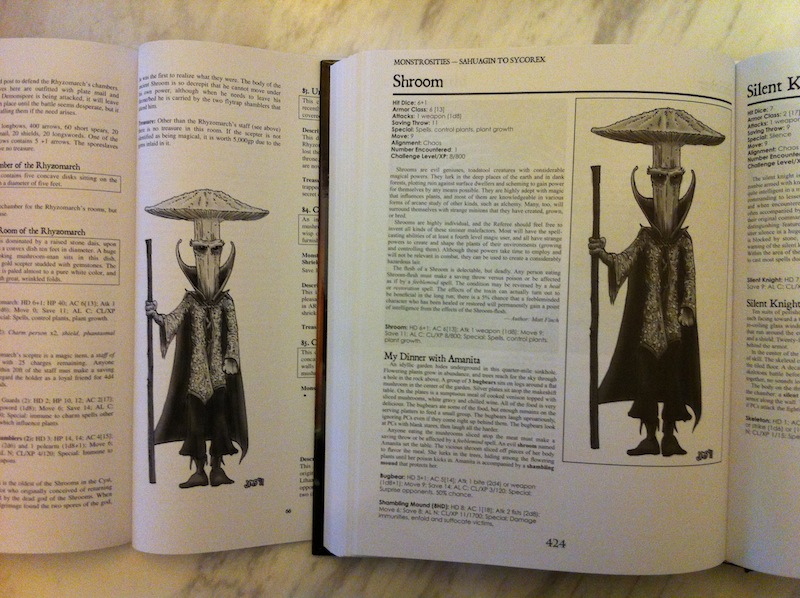Gus just posted about trick monsters, focusing on special attack modes (attacks that rust PC equipment, poison, and so forth). While I think attack modes can be a useful device to distinguish monsters, and can add to the puzzle nature of enemies, it is weaknesses and attack patterns that truly add distinctiveness to an enemy. Special attack modes can increase the danger of an opponent, and reward players for learning to avoid the attack (such as fighting poisonous giant spiders only from range), but can also make monsters more of a hazard to be avoided rather than a puzzle to be solved. This is not necessarily a bad thing–I certainly think pure hazard monsters have a place–but there are other opportunities available in monster design as well.
First, let’s review some weaknesses present in classic monsters. The basilisk can be petrified by its own gaze, though few guidelines other than requiring light at least equivalent to a torch are given. The bulette is AC -2 in most places, but only AC 6 under its raised crest and AC 4 at its eyes. Presumably those areas can be targeted using called shots. Chimeras have variable AC based on front, side, and rear. Dragons are vain, covetous, greedy, and vulnerable to flattery. Surprisingly, there seem to be few elemental vulnerabilities. Salamanders, which are fire based monsters, take an extra point of damage per die from cold attacks, and there are a few other cases like that, but, for example, while frost giants are immune to cold, they do not seem to take any extra damage from fire attacks. Many (all?) undead take damage from holy water. Rakshasas are killed instantly by blessed crossbow bolts. Puddings and oozes have a nice collection of reactions to various attack types that are too complicated to list here but have some interesting effects on gameplay. Giant slugs are not actually vulnerable to salt.
Many “vulnerabilities” are actually just the only way to damage a monster that is otherwise immune to attack. Lasting damage can only be dealt to a troll using fire or acid, for example, and wights can only be damaged by silver or enchanted weapons. This penchant for increasing monster danger by making them impervious to everything other than a few carefully chosen attack modes is appropriate for some creatures when easily intuited (ghosts being immune to physical blows, fire elementals being immune to fire, and so forth), but may not be the best approach in all cases.
Attack patterns are rarely seen in traditional D&D monsters, and this is a shame, because they potentially allow players to learn about monsters experientially in addition to via clues and rumors. 4E has a few nods in this direction, though they are more often phrased as capabilities and concerned more with balancing numbers than they are with encoding combat dynamics (the 4E approach to monster weaknesses was more about the four different defenses, which unfortunately are more about monster level than anything else). Giving some attacks a “recharge” limiting its ability to be used sequentially is a nice, usable mechanic, however.
I have been playing a lot of Dark Souls recently (more on that later in the form of a massive upcoming post), which has exceptionally good monster design. So as an exercise, I will stat up the Asylum Demon. Minor spoiler warning here I suppose, though this is only the first boss in the game. It is really part of the tutorial level, so I feel justified in potentially exposing some secrets. Now, this should be a massively punishing encounter if faced head-on, but should be possible to defeat, even for a basically equipped first level party, if approached intelligently. I added some touches of my own to help migrate from the video game to the tabletop context. I chose this monster in particular because it is essentially a physical beast that does not rely in its design on vulnerability to specific energy types or similar things and effectiveness fighting it should depend primarily on tactical decisions. Numerical scale assumes OD&D but would probably work okay in B/X or AD&D as well, with slightly lessened difficulty.
Here is a good video of the fight against the Asylum Demon.
Asylum Demon

Asylum demon gonna step on you (source)
HD 10, AC as chain (5/14), movement as encumbered human (lumbering walk and awkward flying). Any human not lugging a chest or similar oversized object will be able to outrun the asylum demon.
Asylum demons are horrific, bulbous, brutal demons. They are often guardians unable to range extensively from their post.
Several enemies near: horizontal weapon sweep attack, +10 vs. AC, 1d6 damage, compare one attack roll to all nearby enemies.
A good target at reach: hammer slam 2d6 damage, save (vs. stone?) for half.
No enemies near: fly awkwardly up towards biggest cluster of opponents and attempt to position for good attack next round. Any opponents that do not scatter additionally subject to stomp next round for 1d6 damage, save (vs. stone?) for half.
Weak in the mouth, back of neck, and rear shank. Called shot to the mouth is possible with reach (if adjacent or climbing/grappling) or missile weapons at -4. Accessing the back of the neck requires either jumping from above or climbing first. Successful attack against the mouth or rear shank deals +1d6 damage and to the back of the neck deals +2d6 damage (other additional backstab damage may also apply).
Immune to ranged attacks from human scale missiles such as arrows, bolts, or hurled spears. They “stick it its leathery hide ineffectually.”
Clues: it roars periodically, “exposing pink, fleshy mouth skin.” Anyone behind the demon should notice the “mottled, unprotected rear shank” (though note the demon will never expose this area unless proactively flanked). Consider including balconies or other high vantage points nearby to allow for jump attacks and make sure to mention them when describing the area initially. Asylum demons are huge, lumber brutes and their heavy treads can generally be heard though several walls.
Salvage: asylum demon hide is useful for making leather armor that is particularly protective versus piercing attacks (as plate versus piercing, 1d6 suits worth per demon skin). The weapons they carry are quite fearsome, but may require superhuman strength to wield effectively (yeah, this depends on some other subsystem or ruling that I am not going to get into here).
Is this too much text for a single monster? Perhaps. It is always hard to gauge for yourself how useful a writeup will be to others since, as the author, you already have a good idea in your head of what it is you are going for, but I think this compares favorably with many published monsters, and I think the trigger/action format, with important points emphasized, would be easier to use at the table.
The 2E monstrous manual presented foes as a collection of common game stats (AC, movement, HD, THAC0, etc) along with sections on combat, habitat/society, and ecology. While there are nuggets of useful game info buried within these page-long entries, and some creative world building, for purposes of running encounters it seems like some other categories might be more useful. Triggers for different kinds of attacks, clues to weaknesses, and guidelines for placement, as shown in the asylum demon entry above, are all candidates. Also, fears, hates, and desires. Some such things can often be derived from common knowledge (such as wild animals or carnivores being able to be distracted with rations or livestock), but other details may merit a mention (for example, the wraiths in the Vaults of Pahvelorn will often not molest intruders if they are brought sacrifices to drain). I clued that with remains of previous sacrifices.
All D&D examples in this post were drawn from the 2E Monstrous Manual because it was nearby.
























